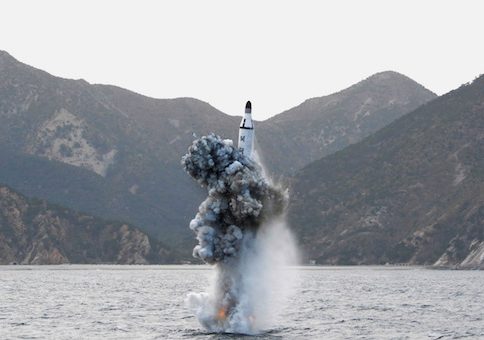By: Ju-min Park and Idrees Ali
North Korea fired a ballistic missile on Sunday in defiance of calls to rein in its weapons program, days after a new leader in its old rival South Korea came to power pledging to engage it in dialogue.
The U.S. Pacific Command said it was assessing the type of missile but it was "not consistent with an intercontinental ballistic missile". Japanese Defense Minister Tomomi Inada said the missile could be of a new type.
The missile flew 700 km (430 miles) and reached an altitude of more than 2,000 km (1,245 miles), according to officials in South Korea and Japan, further and higher than an intermediate-range missile North Korea successfully tested in February from the same region of Kusong, northwest of its capital, Pyongyang.
North Korea is widely believed to be developing an intercontinental missile tipped with a nuclear weapon that is capable of reaching the United States.
U.S. President Donald Trump has vowed not to let that happen.
An intercontinental ballistic missile is considered to have a range of more than 6,000 km (3,700 miles).
Experts said the altitude the missile tested on Sunday reached meant it was launched at a high trajectory, which would limit the lateral distance it traveled.
But if it was fired at a standard trajectory, it would have a range of at least 4,000 km (2,500 miles), experts said.
Kim Dong-yub, of Kyungnam University's Institute of Far Eastern Studies in Seoul, said he estimated a standard trajectory would give it a range of 6,000 km.
Japan said the missile flew for 30 minutes before dropping into the sea between North Korea's east coast and Japan. The North has consistently test-fired missiles in that direction.
"The launch may indeed represent a new missile with a long range," said Jonathan McDowell of the Harvard Smithsonian Center for Astrophysics, referring to the estimated altitude of more than 2,000 km. "It is definitely concerning."
In Washington, the White House said Trump "cannot imagine Russia is pleased" with the test as the missile landed closer to Russia than to Japan.
With the missile impacting so close to Russian soil – in fact, closer to Russia than to Japan – the President cannot imagine that Russia is pleased," it said.
The launch served as a call for all nations to implement stronger sanctions against North Korea, it added.
'CLEAR VIOLATION'
Speaking in Beijing, Dmitry Peskov, Russian President Vladimir Putin's spokesman, told reporters Putin and Chinese President Xi Jinping had discussed the situation on the Korean peninsula, including the latest missile launch and expressed "mutual concerns" about growing tension.
Putin is in Beijing for a conference on a plan for a new Silk Road. Delegations from the United States, South Korea and North Korea are also there.
The launch, at 5:27 a.m. Seoul time (2027 GMT Saturday), came two weeks after North Korea fired a missile that disintegrated minutes into flight, marking its fourth consecutive failure since March.
South Korean President Moon Jae-in, who took office on Wednesday, held his first National Security Council in response to the launch, which he called a "clear violation" of U.N. Security Council resolutions, his office said.
"The president said while South Korea remains open to the possibility of dialogue with North Korea, it is only possible when the North shows a change in attitude," Yoon Young-chan, Moon's press secretary, told a briefing.
Moon won Tuesday's election on a platform of a moderate approach to North Korea and has said he would be willing to go to Pyongyang under the right circumstances, arguing dialogue must be used in parallel with sanctions.
China, the North's sole main ally which nevertheless objects to its weapons programs, called for restraint and for no one to exacerbate tension.
"China opposes relevant launch activities by North Korea that are contrary to Security Council resolutions," China's foreign ministry said in a statement.
The launch will also complicate Moon's efforts to mend ties with China that have been strained by a decision by South Korea's former government to deploy a U.S. anti-missile defense system aimed at defending against North Korea, but which China sees as a threat to its security.
Moon told Chinese President Xi last week that it would be difficult to resolve the issue unless North Korea stopped being provocative.
Japanese Prime Minister Shinzo Abe said North Korea's missile launches were a "grave threat to our country and a clear violation of UN resolutions".
North Korea on Feb. 12, launched the Pukguksong-2 missile, an upgraded, extended-range version of its submarine-launched ballistic missile, from the same site.
South Korean and U.S. military officials said the February launch was a significant development as it successfully tested a solid-fuel engine from a mobile launcher. The missile flew about 500 km with an altitude of 550 km.
The North attempted but failed to test-launch ballistic missiles four times in the past two months but has conducted various tests since the beginning of last year at an unprecedented pace.
It also conducted its fourth and fifth nuclear tests last year.
Trump warned in an interview with Reuters in April that a "major, major conflict" with the North was possible but he would prefer a diplomatic outcome.
Trump has also said he would be "honored" to meet North Korean leader Kim Jong Un under the right circumstances.
On Saturday, a top North Korean diplomat said it was open to dialogue with the Trump administration under the right conditions.
(Additional reporting by Linda Sieg and Nobuhiro Kubo in TOKYO, Christine Kim in SEOUL, and Ben Blanchard and Denis Dyomkin in BEIJING; Writing by Jack Kim and Soyoung Kim; Editing by Neil Fullick, Robert Birsel)
